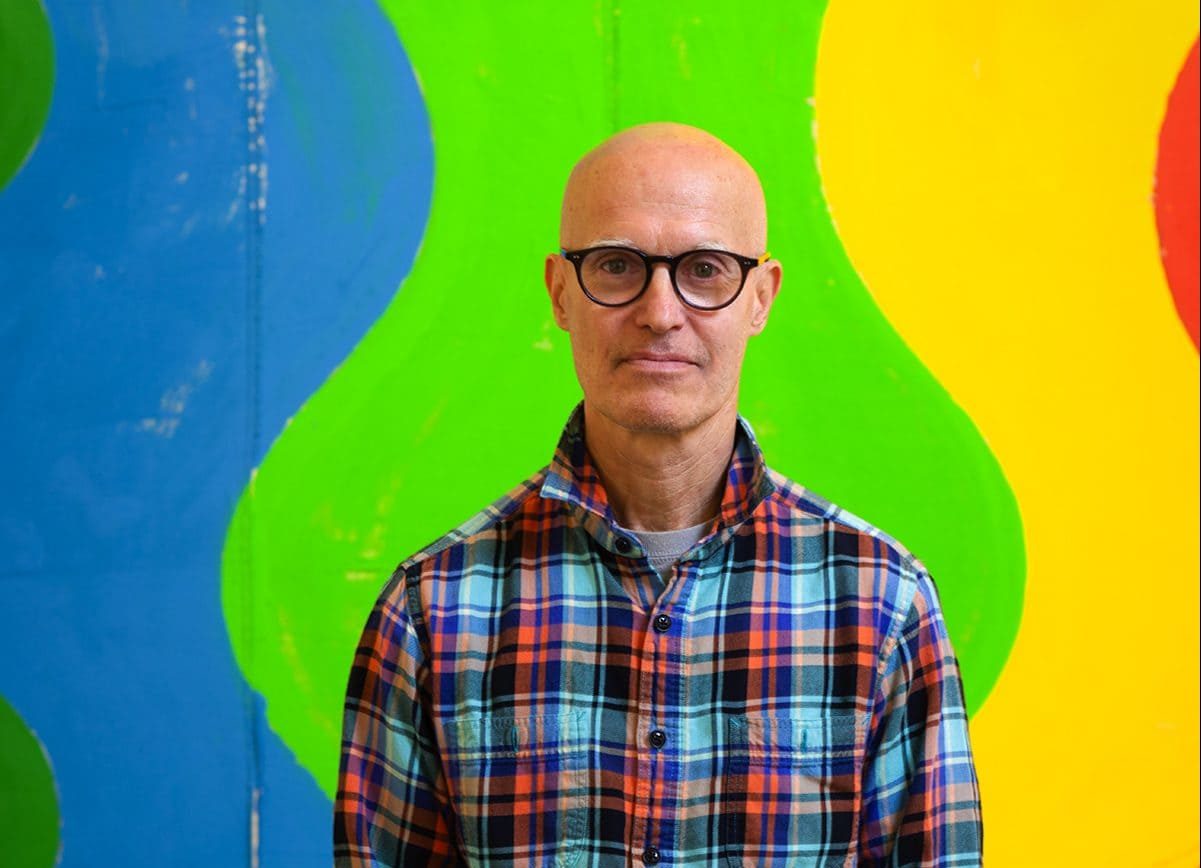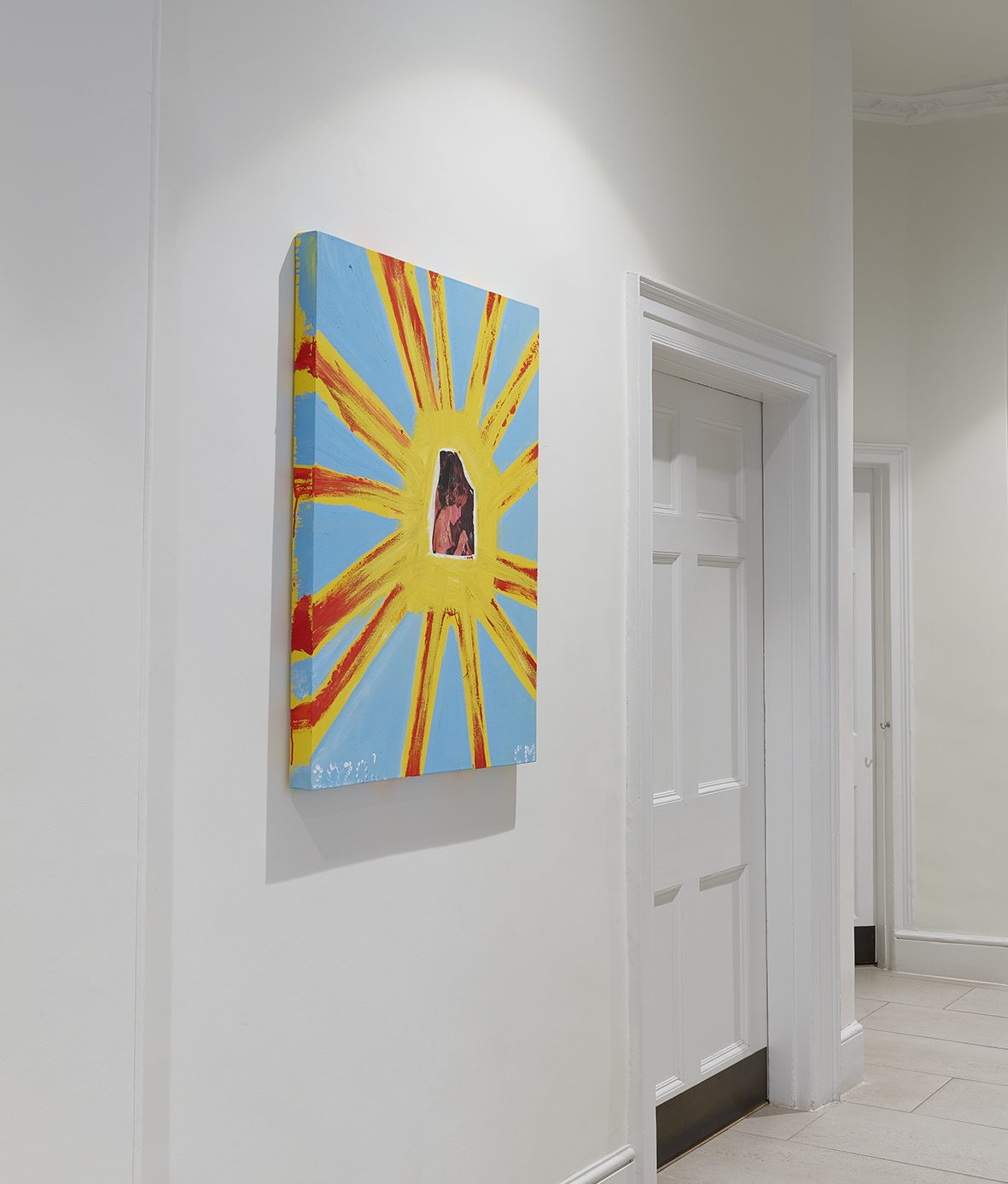
From graffiti to Basquiat to art therapy amidst New York’s Aids epidemic, you could talk to him for hours about the past, but American expressionist Chris Martin’s work still wows in the present. He takes Archie Brydon around his new show, After the Rain, currently on display at the Timothy Taylor Gallery until April 29.
In November 2021, the New York based street artist known as Rambo passed away from an overdose. Rambo – full name Lance De Los Reyes – had made a name for himself painting poems on billboards running along the Brooklyn-Queens Expressway. His thought-provoking apothegms, scribbled across New York City’s abandoned surfaces, drew parallels to another pioneering artist and graffiti wordsmith. De Los Reyes once cited watching Julian Schnabel’s Basquiat biopic as the moment he realised he could pursue a career in art. He was 44 years old.
I’m standing on the first floor of the Timothy Taylor Gallery in Mayfair, looking at a canvas covered in purple glitter. “That painting there is dedicated to Lance De Los Reyes,” Chris Martin tells me. “He was a very cool, very interesting man. A real friend of mine. And he became a really terrific painter. After the morning I heard he died, I painted for a couple of days and they were all for him. There’s about ten paintings I made, just dedicated to Lance, thinking about him and his fearlessness.”

Two works from After the Rain. The painting on the left is dedicated to Lance De Los Reyes.
Chris is in London for his new show, After the Rain. It’s his first show in the British capital, and features works created in upstate New York’s Catskill Mountains over the last 24-36 months. Although they’ve crossed the Atlantic to the more austere setting of a Mayfair gallery, there’s an irreverence to the work. The first piece I see is built around a shimmering desert postcard – the kind you’d expect to find on turnstile stands outside dodgy tourist shops in New York for 99¢. On my way upstairs, I see an eccentric homage to Amy Winehouse. In the room where Chris greets me, there stands a big 6-footer, stretching floor to ceiling, with a piece of Bounty kitchen roll stuck on and painted green. As for the glitter, well it’s by no means confined to the purple canvas dedicated to De Los Reyes.
The paintings can tackle huge, often existential questions, but they’re fun. So, it turns out, is talking to Chris Martin.

Chris Martin.

A billboard painted by graffiti artist Rambo, reading, “BLESS YOURSELF THE LIGHT BEARERS ARE BEING REBORN. REAL TALK. RAMBO.”
Chris reveals he once gave a pair of large-scale paintings to De Los Reyes. Rambo – metamorphosis complete – was determined to get the pair up on a BQE billboard. “I remember him telling me how they were going to get me up there, because you had to bring this secret ladder to get to the other ladder. He kept saying it’s not gonna be a problem, but the more he told me about it, the more I realised, I’m a little bit old for this. I don’t want to die. They risked their lives to make those paintings.”
Graffiti has always been an inspiration of Chris’. After growing up in Washington, D.C., he attended Yale for two years before moving to downtown New York at the turn of the 80s, where he found himself surrounded by street art. “There was all this terrific work going on and I was very influenced by it. The subway cars were completely covered. The thing about working on the street is, if you’re lucky, you get an hour. It’s a proper show. There’s energy. You’ve got to know what you’re doing, and if the energy is great, you have these amazing moments.”
Few eras, let alone moments, have ever produced an artistic energy like downtown New York in the early 80s. Chris was in its bohemian heart. He lived next to Glenn O’Brien, then of Interview magazine, and long-time “The Style Guy” at GQ. He lived above the Mudd Club, an infamous hotspot for the likes of Haring, Warhol and Basquiat. From his apartment, he could look down on a garage covered in the legendary SAMO© graffiti.
“I remember being really just so impressed with Basquiat when I met him. He was a very beautiful, very handsome, really unique person; but I was most impressed that he had found a way, in his practice, to take all the things that he was interested in or exposed to, and put them into the painting. Sometimes just writing, sometimes sticking…if he was obsessed with a record he’d stick it on. He could put all the sexy stuff in. He could put the horrible social situation and racism in America in. Whatever was happening in his life, he found a way to put it in his paintings. That’s always been very important to me.”


Although he lives in Brooklyn’s Williamsburg, Chris has long painted at his residence in the Catskills. Predominantly working in acrylic, he lays down big surfaces outside and walks over and across them. “It’s a hell of a lot of fun,” he chuckles. “And the other thing that’s interesting is you can’t really see what you’re doing. You’re in it. Then it dries, and you get to see what you’ve been doing.”
As he explains this process, the painting in front of us has a few dead moths scattered across it. They’re dried into the acrylic having gravitated towards its colours while outside in the Catskills. “There’s a quote by the painter William De Kooning,” Chris continues. “He talked about, as an artist, the ideal state as being inside and outside at the same time. Inside, meaning you’re just completely lost. And outside, meaning there’s a part of you asking, ‘Oh, how’s this going?’ Inside – you’re trusting your body and your feelings. Outside – you’re watching yourself work.”
Working outdoors, clambering across these big surfaces, helps incorporate the energy Chris loves from street art. “I’m very interested in that idea of performing the paintings almost as a dance. In that sense, I envy musicians who get an actual gig.” Chris’ is less of a rain dance, and more – as the exhibition’s title, After the Rain, suggests – of a post-downpour performance. When he ventures out into the woods, the sun now coming through the trees while the ground’s still wet, the Catskills are filled with “this incredible light and freshness.”
The Catskills lighting is just one reason behind the exhibition’s name. The other is John Coltrane’s composition of the same name: After the Rain. After growing up in D.C. in the 50s and 60s with the city’s African-American radio playing, he fell in love with the music of the likes of Coltrane, James Brown and Marvin Gaye. He’s always listening to music while he works, more recently devoting a number of paintings to the legacy of Amy Winehouse. “I remember when I first heard her, like many people, I thought she was this middle-aged black woman, and then you see an interview… But what a great songwriter, and just a profound musician. To see what happened, it was like watching a martyr to the culture. Society devoured her.”

One of his Amy Winehouse inspired works.

Hello Harry, featuring a cut out of New York polymath and mystic Harry Smith.
Chris’ paintings often take months and years. When he works, he works quickly, but he’s not afraid to leave pieces and come back to them. Many of the works on display in After the Rain are dated ‘2019-2021’ or ‘2020…’. “The great gift of not working on the street is you have the opportunity to rework paintings,” he tells me. “A few days later, you get to really look at it and see if it’s any good. Am I a genius or was it a bad night? I work on paintings over years – not that I’m working on the painting every day, but I repaint.”
There is a collage quality to Chris’ art. A lot of the works are in fact collages – including Hello Harry, the brilliant piece featuring 20th Century NYC polymath Harry Smith, surrounded by various items Chris chose simply because he liked them – but even when painting, there are layers to his work. He lists Robert Rauschenberg as another early inspiration, which is unsurprising once you see Chris’ work up close.
Perhaps where the collaging is most distinctive, however – certainly among fine art – is in its penchant for glitter. The proclivity began during Chris’ years as an art therapist for HIV/Aids patients in New York, working full-time for nine years between Rivington House on Lower East Side, as well in Red Hook and Harlem.


“My first reaction [to glitter] was, well, this isn’t serious. It’s like day-care. But I realised I really loved it and was inspired by the people I was working with. The basis of art therapy is that you give yourself over to a process and then you get to reflect on what you are showing to yourself.”
Interestingly, it was around this time that Chris really started incorporating the elements of street art he admired into his own product. “I didn’t have the time that I’d had before, but I’d always been interested in making very large paintings and I had to learn how to make really large paintings very quickly. I have a couple of hours, it’s midnight, it’s about getting psyched up, you know?

“Painting is not like a stop sign where you come and you go, ‘Oh, I know what that means.’ I’m the artist and I don’t know what it means. But it doesn’t mean there’s no meaning. It’s not something clear that says, ‘I’m now going to make a painting about the conflict in Ukraine and all the terrible suffering that’s happening.’ There are artists who do that, but that’s not my practice. My practice is to be open enough to images and to what’s happening inside of me, and see the way the world comes into it.
“Take music – you write a song and the lyrics are right there, but the meaning is not just in the lyrics. It’s in everything. It’s the bass. It’s the sound. There’s this energy and this whole anger and sexiness. I may do something and tell myself I know what the story was, but you might come out of there thinking something else. You can feel the energy, but think, ‘This reminds me of a terrible trip to Woodstock.’”
For all the irreverence of his work, Chris’ ideas around art are not only serious, but profound. His intelligence is evident. He is intriguing, but more importantly he’s intrigued – he spent the vast majority of our time talking about other people and other people’s art and only when he had to would he talk about himself. His art is colourful and fun, eclectic and impulsive, but it is not random. Each stroke is deliberate, rooted in meaning from a life of living curiously.


1 Comment
👏